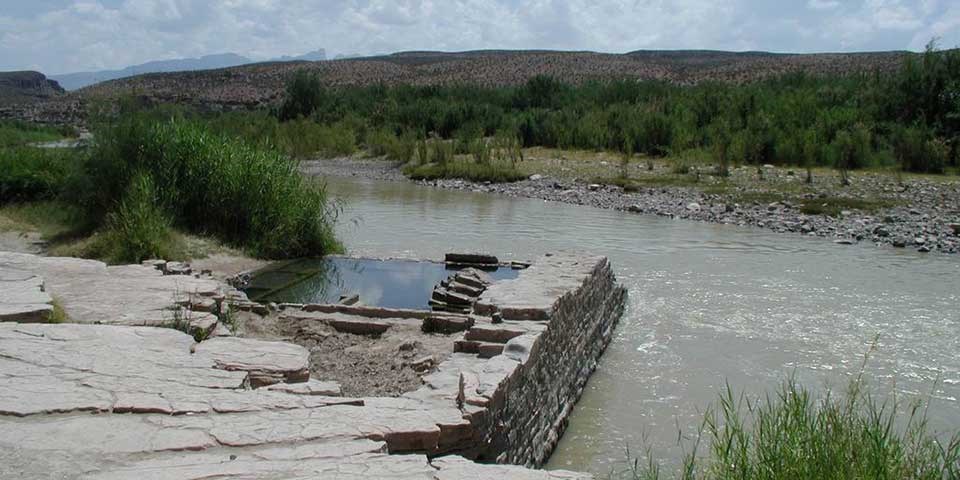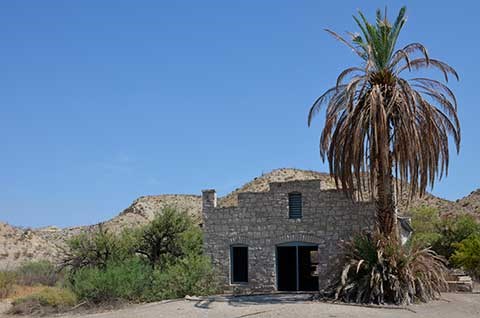Last updated: May 11, 2020
Article
Hot Water, Health, & History

C. Ballou
The hot springs of Big Bend have long been a focal point for tourists and travelers in the desert. But these hot mineral waters represent more than just a destination for visitors to the National Park. For J.O. Langford and his family, they represented health, business and home. And for several decades in the early 20th century, the hot springs were also the center of a desert community.

C. Ballou
Miraculous Healing
In 1909, J.O. Langford was sitting in the lobby of the Alpine Hotel when he overheard someone discussing the miraculous healing properties of the hot springs in the Big Bend country. Another person might have been skeptical of claims that the mineral water could cure any disease, but Langford had been ill since contracting malaria as a child, and had been looking for relief from his pains and sickness ever since. In fact, he was so interested in these springs that he immediately set out to purchase the land surrounding them, down in a remote, lonely country that he’d never even laid eyes on.
Desert Health Resort
Langford set out two weeks later with his pregnant wife Bessie and their young daughter Lovie, and traveled for ten days before finally reaching their new home on the Rio Grande. Regaining his health was a priority, so as soon as they arrived, Langford began his treatment: For 21 days, he drank and bathed in the mineral water of the spring, which at its source reaches 105 degrees, and soon he felt healthier and stronger than ever. Langford recognized the value of the springs and he immediately set up a business. He built a bathhouse and developed his land into a desert health resort. Word-of-mouth recommendations soon brought people from across the country to find health at the springs, and many claimed to have been cured of skin diseases, rheumatism, stomach troubles, and chronic pain.
Border Troubles
Unfortunately, border troubles related to the Mexican Revolution forced the Langfords to abandon their home not long after they had built it. Bands of raiders terrorizing small villages throughout Mexico were pushing further north and crossing the Rio Grande, and many people in the area fled to less turbulent territory. The Langfords moved to El Paso, where they lived for 14 years.
Automobiles, Roads, & The Nearest Post Office For Miles Around
They were finally able to return in 1927. The increasing availability of automobiles and improved roads meant more people were able to come and bathe in the springs. Langford rebuilt his bathhouse and added a store, post office, and motor court to accommodate the growing number of visitors. Because the Hot Springs had the closest post office for many miles, the area became a major center for the widespread community of farmers and homesteaders. People traveled for almost a hundred miles on either side of the border to retrieve their mail from the Hot Springs Post Office, and brought with them many things to sell and trade at the community market that soon developed there. The mailman even built himself a small house to live in part of the week during his frequent trips down from Alpine.
Preserving Big Bend History
Langford and his family lived and prospered in the Hot Springs area until 1942, at which time he sold the land to the state of Texas. The purchase was made in hopes of one day protecting the area, and two years later, Big Bend National Park was established.
While the buildings have been abandoned since the 1950s, they still stand as a reminder of the community they once supported. To this day, you can visit the remains of the general store and motor court. A walk just a quarter mile down the river will bring you to what is left of the main bathhouse, and you too can relax and soak in what J.O. Langford and many other West Texans considered to be healing waters.
By Park Ranger Jeannette Woerner
The Paisano, Volume 37, Number 1 2019
